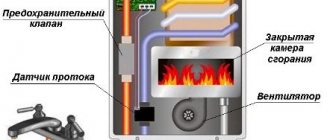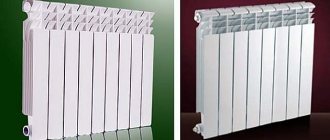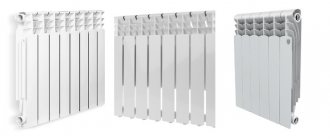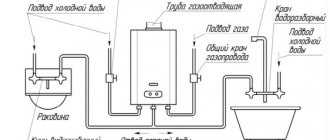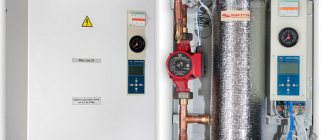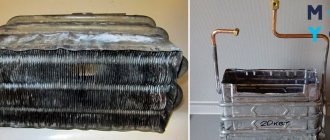Home » Heating and water supply » Gas water heaters » Is it possible to use a gas water heater for heating?
In apartments and small houses, as well as garages, a gas water heater is sometimes used as heating. There are many debates and discussions on this topic on online forums. However, before you bring this idea to life, you should consider all the negative aspects of using a gas water heater instead of a heating boiler.
…
- 1 How to convert a column into a heating boiler?
- 2 Dangers arising when using the column as a boiler
Distinctive features
The purpose of the geyser is to heat water . The characteristics of the device determine how quickly and in what quantity the water can heat up. In order not to make a mistake in choosing a device, you should understand its structure.
The first columns with an open combustion chamber consist of a metal body, a gas burner with an igniter, a heat exchanger, an automatic gas valve with a combustion intensity regulator, a mechanical water unit with a safety valve, an ignition system, a diffuser for connecting the chimney, as well as pipes for supplying water and gas, located at the bottom of the structure.
A device with a closed gas combustion chamber has a similar structure, but has a number of differences:
- the classic burner has been replaced by a stepped or modulating burner, which changes the flame intensity automatically;
- air is forcedly supplied using a fan;
- the flame is ignited automatically through the electrical network or a hydrogenerator;
- after heating, the water temperature is maintained due to the presence of a special sensor connected to the controller.
Important points when renovating a kitchen in a Khrushchev building with a column
When carrying out repairs in a kitchen with a gas water heater, it is necessary to carefully consider the installation of wiring in advance, eliminating the risk of a short circuit when using it. When installing a hood with a chimney pipe, it is imperative to check the effectiveness of the general indoor hood to see if it is clogged with construction debris if the pipe is led into it and not outside.
The efficiency of the exhaust system must be checked by competent organizations.
Pipes in the kitchen are easily covered with special boxes, panels made of stainless steel or other non-combustible materials. They should be easy to dismantle and open. If gas service specialists find completely closed boxes, a fine cannot be avoided.
The dimensions of the cabinet for the geyser are individual and are determined on site in each specific case.
You should be careful when using suspended ceilings. If the chimney pipe goes into the ceiling or runs too close, then it is better to abandon it altogether, since it will not withstand high temperatures.
Important! Before starting a kitchen renovation, during which it is planned to move the gas water heater to another location, it is necessary to coordinate this process with gas services and obtain permission. Self-transfer is prohibited.
Replacement or transfer of communications should be carried out by specialists
Types and description
The store's assortment consists of a huge number of devices with different technical characteristics.
All models can be divided into two types:
- flow-through;
- cumulative.
Flow-through
The column is not equipped with a storage tank and serves to instantly heat up the liquid . Inside the device there is a heat exchanger with a water tube, and under it there is a gas burner. When fuel is burned, heat is generated, which heats the water and sends it through a heat exchanger.
Spent fuel accumulates in the collector and is discharged to the street.
Simple models are equipped with mechanical controls . In more expensive devices, ignition is performed automatically when the hot water tap is turned on. The water temperature is regulated by a standard gearbox or more modern electronics.
The speakers are equipped with an open combustion chamber . The exhaust gas is discharged through a conventional chimney or through a forced ventilation system. The second option is used in apartment buildings.
The devices are equipped with a security system and are therefore safe to use.
Cumulative
The devices are similar to electric boilers . The only difference is the heat source. The base is a container where hot water is stored. The device is equipped with a heat exchanger, inside which combustion products move.
The combustion process occurs in the lower part of the structure, where the burner is located . Special dividers are provided so that the gas gives off heat when moving upward.
Advantages and disadvantages
Advantages:
- Compactness. Even the unit with the tank does not take up much space, so it can be successfully camouflaged indoors.
- Saving. Heating water with gas is cheaper than heating water with electricity. Heating water in this way costs less than centralized hot water supply.
- Several water intake points. A flow-through gas water heater is sufficient to heat water for three or more points. A device with a power of 8 kW or more, which is connected, is sufficient.
- Low price. The devices are cheaper than devices powered by electricity. The range of brands includes many models at budget prices that are not inferior to more expensive devices.
Flaws:
- Difficult installation. Gas water heaters are more difficult to install than electric water heaters. Besides, you can’t do it without outside help. It is necessary to call specialists and also obtain permission to install the equipment.
- High power. The gas main must have high power, so installing a water heater in many apartment buildings is problematic.
- Removal of combustion products. The waste generated after combustion must be disposed of somewhere. It is necessary to organize a chimney. This is easy to do if a person lives on the top floor. Others will have to build the system from the outer wall of the house or install a turbine column, then make a special hole in the wall.
- Danger. The risk of an emergency should be minimized by installing a column with a protective system. Most modern devices have a security system. It is also necessary to ensure a regular supply of fresh air: 10 units of oxygen per 1 unit of volume of gas burned.
Accommodation options
Hidden way
When placing equipment behind facades, the following points must be taken into account:
- The gap between the column and the inside of the cabinet should be 3 cm or more (fire safety);
- Ventilation holes should be made in the module;
- It is better to insulate the cabinet from the inside using a special layer that reflects heat;
- When accepting furniture, check for the presence of openings for the gas system (corrugations and pipes).
Here the column was built into the corner top module. False MDF facades follow the outline of the kitchen and hide the gas pipes.
When carrying out renovations, the problem of some houses is the design of a kitchen with a gas water heater. This object not only affects the visual perception of the new interior, but also partially limits the functional use of the space. It is necessary to think in advance about the best options for solving this problem in order to achieve maximum benefit for yourself.
Modern models with stylish design
How to choose and what to pay attention to - 10 tips from a professional
When choosing a column, you need to pay attention to the number of water intake points that the device will serve, and the volume of hot water, which is calculated based on the needs of the family. There are other parameters that you should also take time to study.
Volume of the tank
The main disadvantage of a boiler is the limitation in the amount of water . When the tank is empty, you need to wait half an hour or more for the required amount of water to heat up.
To reduce this minus to a minimum, you need to calculate the required tank volume. It is necessary to take into account the volume for washing and other needs.
NOTE!
It is worth noting that too large a boiler can lead to unnecessary costs, so you should not ignore this point.
You can determine your needs using the information given in the table.
| Needs | Volume of water in liters | Water supply liter/minute | Temperature 0C |
| Taking a bath | 120 | 15 | 42 |
| Shower | 35 | 6,5 | 42 |
| Hand washing | 4 | 7 | 42 |
| Washing dishes | 30 | 8 | 55 |
| Washing | 9 | 7 | 42 |
| Shaving | 9 | 7 | 55 |
The table contains data for providing hot water to one person in an apartment or private house . With simple calculations it is easy to find out how much water is required for several people. A boiler with a capacity of 80 liters is enough for two people, and 100 liters for three people.
To ensure a complete hot water supply in a house with several bathrooms, it is worth purchasing a heater with a volume of 180 liters or more to create comfortable living conditions for all family members.
The exact calculation is made using the formula: V = N x (t0 – t1) : (t2 – t1), where:
- V —boiler volume;
- N is the amount of water;
- t0 —heating temperature;
- t1 - cold water;
- t2 is the intensity of hot water supply.
Power
Power determines the performance of the device and shows how much water it can heat in a minute . When assessing the power of a particular model, it is worth taking into account the number of people living in the apartment and how many of them will use hot water at the same time.
One tap flows about 6-7 liters of water per minute . After multiplying this parameter by the number of mixers, the result can be calculated. Manufacturers indicate power in the documentation for the equipment.
Based on power, speakers are divided into the following types:
- Minimum power 17-20 kW . Devices with such characteristics are enough to supply water to one point, since their productivity is 9-10 liters per minute. The best option for 1-2 people. The only drawback is that it will be problematic to shower and wash dishes at the same time.
- Average power 20-26 kW . The unit is capable of heating from 15 to 20 liters of water per minute. Suitable for 2-3 water intake points. The most popular option.
- High power from 26 kW . The equipment is intended for installation in private homes and is designed for large families.
Centralized hot water supply is certainly a convenient thing. But often, when moving into an apartment rented or purchased on the secondary housing market, we are faced with an outlandish unit - an old gas water heater. How can it be used safely?
A gas water heater, or, as it is officially called, a flow-through gas water heater, appeared in our country with the beginning of mass housing construction in the 50s of the twentieth century. It was the installation of geysers in apartments that made it possible to quickly solve the problem with hot water supply without the construction of expensive heating plants and pipeline networks.
How to determine the type of geyser?
First of all, let's define the terminology - we will call the old one a geyser, the design of which includes a constantly burning ignition wick. The wick is ignited with a match or, in more modern models, with a spark from a manual piezoelectric igniter.
The overwhelming majority of geysers installed in “Stalinka” and “Khrushchev” buildings belong to two varieties - KGI-56 and similar in design L-1, L-2, L-3, GVA-1, GVA-3, early VPG models. It is easy to distinguish them from each other by their control knobs.
The KGI-56 water heater (gas water heater, designed in 1956) was widely used in the construction of multi-story buildings in the 50-60s of the last century. It has a rectangular, slightly rounded body with an oval hole for ignition and two levers in the lower part of the body - a lever for turning on the pilot burner and a lever for controlling the power of the main burner. In later versions, a solenoid gas valve button is also installed on the front panel.
Dispensers of the L (Leningrad), GVA (automatic gas water heater), VPG (instantaneous gas water heater) series are structurally similar and have one rotary knob in the center and (optional) a solenoid gas valve button.
HSV dispensers became perhaps the most common in Russia and were produced in huge quantities under various names (Neva 3208, Neva 3210, Neva 3212, Neva 3216, Darina 3010 and others).
The era of mass installation of geysers in our country was short-lived - after 20-25 years, almost all new buildings were connected to hot water supply networks. Columns remained a distinctive feature of “Stalin” and “Khrushchev” buildings. But their owners don’t complain – this is Russia. And while the “lucky ones” with a centralized hot water supply heat water in a basin on the stove every summer for two or three weeks, they calmly use hot water. And a gas water heater costs significantly less than hot water from pipes.
And that’s probably why residents of new buildings tell each other horror stories about an unknown and terrible device - a gas water heater. And it breaks down every other day, and it takes a long time to light it, and it’s dangerous to use it. Is it really?
Is it safe to use an old gas water heater?
A person accustomed to centralized hot water supply usually judges the safety of a gas water heater based on rumors and speculation of friends and acquaintances. Often these people have never even seen a gas water heater, especially an older one. Hence, terrible legends about almost daily explosions of gas water pumps are multiplying. It gets to the point that some families, living in a rented apartment and having a fully functional appliance, heat hot water in a basin on the stove.
All these horror stories are greatly exaggerated. Any geyser, even if it was made half a century ago, has safety devices in its design. Such devices include a water regulator, a flame sensor and a draft sensor.
The water regulator is based on the properties of the Venturi nozzle and allows you to turn on the column only when a sufficient amount of water flows through the column. All geysers, including the most modern ones, operate on this principle.
The operation of the flame presence sensor is based on the thermal effect of the pilot burner flame on a bimetallic plate or thermocouple. In a design with a bimetallic plate, when the igniter is burning properly, the bimetallic plate, bending, presses on the valve stem and opens gas access to the main burner. When the flame goes out, the plate cools down, straightens, and the valve shuts off the gas supply to the main burner. Gas continues to flow to the pilot burner, but this weak flow does not pose a danger.
The design with a thermocouple is more advanced. The thermocouple, heated by the pilot burner flame, generates an electric current that holds the solenoid gas valve open. When the flame goes out, the thermocouple cools down, the current stops being generated, and the valve closes under the action of a spring. In this case, the gas supply is cut off to both the main and ignition burners.
The traction sensor also comes in two versions. In one of them, air for the pilot burner flame is taken through a tube from under the upper casing of the column. In the absence of draft, carbon dioxide and carbon monoxide accumulate there, which, flowing through the tube instead of fresh air, extinguish the igniter. After this, the flame presence sensor is triggered and shuts off the gas supply.
Solenoid valve designs often use a bimetallic fuse inserted into the gap between the solenoid valve and the flame sensor thermocouple. A bimetallic fuse is also installed under the upper casing and, in the absence of traction, quickly overheats and trips. The contact between the thermocouple and the solenoid valve is broken and the valve shuts off the gas supply.
The joint operation of all these safety devices makes the operation of the gas water heater simple and safe.
How to light an old gas water heater?
If you see a gas water heater for the first time in your life, then the best option would be to invite someone who will show you how to handle it. The world is not without good people, not just one, but another neighbor will probably not refuse to help you. But sometimes there is no one to turn to, and you have to figure it out on your own. By the way, situations are not uncommon when people who have been using a gas water heater for years do it incorrectly, and only smart safety automation saves them from harm. Therefore, recommendations in any case will not be superfluous.
Before starting the old gas water heater for the first time, especially after a long break, it is necessary to carry out several auxiliary operations.
unobstructed air access to the kitchen where the gas heater is installed . By the way, this is why the kitchen door is different from other internal doors in the apartment - a gap of at least 5 cm is left under it, it is forbidden to seal it. This is especially true if the kitchen has simple plastic windows without ventilation devices.
In old houses, sometimes there is a gas water heater installed in the bathroom. According to modern requirements, this is not allowed, since the risk of carbon monoxide poisoning is too great. In this case, the most correct thing would be to install a stop that does not allow the door to the bathroom to be tightly closed. A gap of 3-5 cm will be quite sufficient. Yes, it is not very convenient, but life is more valuable.
2. Check for draft in the chimney. This is usually done using a strip of thin paper, bringing it to the slot under the top cap of the column. The strip should vibrate or deviate noticeably towards the chimney.
If draft is not detected, then the chimney should be checked. For this purpose, there is an inspection hatch in the wall - it is located 20-30 cm under the place where the chimney pipe of the column goes into the wall. Sometimes during repairs the hatch is sealed so that it is impossible to open it. But there is no other way out; we have to break it. Several kilograms of dust, fragments of bricks and other debris are usually found in the hatch opening. All this must be removed and try to inspect the chimney using a mirror. If it is pitch black, you will have to call a service company to clean it.
It happens that there is no draft even when the chimney is clean, this is due to stagnation of cold air in the pipe. In this case, you need to burn an old newspaper in the inspection hatch, the air will warm up and the draft will be restored.
3. Open the gas inlet valve on the gas pipe. smell of gas near the gas water heater . But in any case, it is advisable to check all gas pipe connections using a soap solution. If you detect even a tiny leak, call gas workers to fix the problem.
Now, after all the preparations, the column can be lit. To do this, you will need regular or, for the first time, fireplace matches. Fireplace matches are long and will allow you to light the column without any worries. After this, you will be able to take a good look at the wick and understand where and how to place the short match during subsequent ignitions.
How to light a gas water heater type KGI-56?
1. Open the taps on the gas and cold water supply pipes.
2. Make sure there is traction.
3. Move the left column lever to the left all the way.
4. Press the gas solenoid valve button (if equipped) all the way.
5. Light the wick with a match through the hole in the front panel, do not release the valve button for 10-15 seconds.
6. Release the valve button. If the wick goes out, then ignition is repeated, increasing the valve holding time. Sometimes the valve has to be held for up to 50-70 seconds, but this is a sign of its imminent failure.
7. If there is no solenoid valve, then after igniting the wick you need to wait 15-20 seconds for the bimetallic flame sensor to operate.
8. Open the hot water tap in the kitchen or bathroom.
9. Quickly move the second lever to the left; the main burner should light up.
10. Move the second lever to adjust the hot water temperature. You should not regulate the temperature by adding cold water in the mixer; this leads to rapid scale formation in the heat exchanger.
How to light a gas water heater L-1, L-2, L-3, GVA-1. GVA-3, HSV?
1. Open the taps on the gas and cold water supply pipes.
2. Make sure there is traction.
3. Turn the knob clockwise to the first mark. Some speakers have a stopper in this position that prevents you from turning the knob further.
4. Press the gas solenoid valve button (if equipped) all the way.
5. Light the wick with a match through the hole in the front panel, do not release the valve button for 10-15 seconds. Some designs provide a manual piezoelectric igniter; its button is located at the bottom of the column; find it in advance. Don’t be surprised if you can’t light the fuse with this igniter; in many columns it’s faulty.
6. Release the valve button. If the wick goes out, then ignition is repeated, increasing the valve holding time. Sometimes the valve has to be held for up to 50-70 seconds, but this is a sign of its imminent failure.
7. If there is no solenoid valve, then after igniting the wick you need to wait 15-20 seconds for the bimetallic flame sensor to operate.
8. Open the hot water tap in the kitchen or bathroom.
9. Quickly turn the knob clockwise, slightly short of reaching the final position, the main burner should light up. In a design with a stopper, to turn the handle from the “wick” position, it must be pressed.
10. Rotate the knob to adjust the hot water temperature. You should not regulate the temperature by adding cold water in the mixer; this leads to rapid scale formation in the heat exchanger.
How to turn off the gas water heater correctly?
If you are planning a short break from using hot water, simply close the hot water tap. The main burner of the column will go out, but the wick will remain burning. When you open the tap, the column will turn on automatically. Most owners light the wick once in the morning and extinguish it late in the evening.
To completely turn off the column when the main burner is burning, use levers or a handle to turn off the gas supply to the burner and wick, and after 10-15 seconds (after the flowing water has cooled), close the inlet taps on the water and gas pipes.
How to check the serviceability of a gas water heater?
If the first ignition was successful, then the column can be used. But before that, you need to make sure that the column is fully operational. Everything is ok if:
- when the hot water tap is closed, the wick burns with a calm blue flame with a characteristic, but not excessive noise;
— when you open the hot water tap, the column turns on softly, without pops or explosions;
— the main burner burns with a non-smoking blue or light yellow flame;
— when closing the taps at the water collection points or on the inlet pipe, the column goes out immediately, without delay;
— the column allows you to regulate the temperature of hot water from barely warm to scalding hot;
— the speaker does not turn off spontaneously during use.
If any of the above is not met, then the column must be repaired or, if repair is not profitable, replaced with a new one.
Please note that 5-10 seconds after turning on the column, very hot water may flow from the tap for several seconds, gradually being replaced by water at the set temperature. If you're not used to it, you can get burned, but this is not a malfunction, but a design feature.
Is it possible to use a faulty gas water heater?
There can only be one answer to this question: absolutely not! And don’t let people who successfully operate a gas water heater with minor or not-so-minor defects convince you.
The point here is this. Finding an old gas water heater from the 50s-70s in perfect working order is quite difficult. Most often, it is the flame control system that fails; even the new one was not very reliable. Therefore, quite often the gas valves in the dispensers are stuck open. Even the gas workers themselves did this, since spare parts were tight. This is easy to determine - the gas valve button is not pressed or is pressed very easily. With some care, such a column works without problems.
Sometimes the water regulator is faulty. The author himself used a column with this problem for several years. I had to turn on the water and then light the column manually. When turning off, it was necessary to close the gas supply to the main burner and only then turn off the water. This was common, and more than once I ended up boiling the column due to forgetfulness.
But for a person accustomed to using centralized hot water supply, this is unacceptable! Habits developed over the years are very difficult to change. You can bet anything that on the very first day you will boil a column with a faulty water regulator. Therefore, the device must be in full working order.
We recommend reading
- How to choose a water filter?
- Restoring the IconBit NetTAB MATRIX HD tablet
- How does the water regulator of the Neva 3208 geyser work?
- Operating instructions for the gas water heater Neva-3208
- Is it profitable to install multi-tariff electricity meters?
- How to choose a juicer?
- Repair of juicer SV-1
- How to check an electric meter at home?
- How to connect a second TV? As easy as pie!
- Repair of geyser Neva 3208 – low water pressure
Device performance
Productivity is measured in liters per minute and is indicated in the device passport . The required productivity can be determined taking into account the number of mixers. One tap flows 6-7 liters per minute.
If you need a dispenser for an apartment with two mixers, then the capacity should be 13 liters per minute . Using the table above, you can determine the required equipment performance.
Maximum heating temperature
To increase the volume of hot water with low consumption of reserves from the boiler, you should choose a column with water heating to 75-80°C . For example: 100 liters of water from a tank at a temperature of 60°C when mixed with a cold one of 15°C will give 180 liters of 40°C.
If the water temperature in the boiler is 80°C, then with 100 liters you can get 260 liters of warm water.
Tank inner lining
The durability of the equipment depends on the quality of the material:
- steel is an inexpensive and reliable material that is resistant to corrosion and high temperatures;
- copper - has similar properties, but has a higher heat transfer, which allows you to obtain maximum heat during fuel combustion.
Types of ignition
Speakers come into action in different ways:
- manual ignition - the flame appears after turning the knob to supply gas and placing a match in this area;
- button - the unit is equipped with a button, when pressed, fuel is supplied;
- electric ignition - connecting the unit using an electrical network;
- electronic control - hot water is supplied automatically when the tap is turned on;
- battery-powered electric ignition is an electronically controlled system where you can monitor the charge level on the LCD display.
Removal of combustion products
Depending on the type of carbon monoxide output, the columns are of the following types::
- with a chimney - the classic option, when spent fuel exits through the roof;
- without a chimney - a hole is made in the wall through which carbon monoxide is removed using forced ventilation.
Popular manufacturers and their descriptions
The manufacturer is one of the important points that buyers pay attention to when choosing gas equipment.
Most of them pay attention to products from trusted brands, since their units are reliable and have a long service life.
Popular brands:
- Zanussi . A well-known Italian manufacturer that has proven itself well. The range includes classic units and models with additional functionality.
- Electrolux . A Swedish company that produces devices of the highest quality and sells them at an average cost. The speakers are made of reliable materials. Due to copper heat exchangers, corrosion processes are excluded.
- Bosch . The German concern is constantly improving. All products are high quality and reliable. The models are equipped with power regulators, allowing you to set the desired water temperature.
- Ariston . Products from the Italian company are sold at affordable prices. There are devices with mechanical and electronic control types. The products are made from reliable materials that guarantee a long service life.
Rating of the TOP 5 best models
| Place | Name | Price |
| TOP 5 best geysers | ||
| 1 | Zanussi GWH 10 Fonte | 7 000 ₽ |
| 2 | Electrolux GWH 11 PRO Inverter | 13 000 ₽ |
| 3 | Bosch WR 10-2P23 | 12 000 ₽ |
| 4 | Zanussi GWH 10 Fonte Turbo | 7 000 ₽ |
| 5 | Ariston FAST EVO ONT C 11 NG RU | 11 000 ₽ |
Skillful design solutions
The presence of gas equipment in the kitchen does not mean that it will no longer be possible to realize an interesting, modern room design. With the help of smart design solutions, the speaker can be used so advantageously in the interior that it will be almost invisible.
- Choose a white kitchen set and against its background the metal body will not be noticeable. Light furniture will visually expand the walls, creating the illusion of space.
- An interesting option would be with a contrasting black and white facade of cabinets, where the column can easily get lost.
- For colored kitchen furniture, you can repaint the speaker body itself to match the cabinets.
A kitchen with a gas heater can look attractive
Open placement of a geyser is welcome in a kitchen interior with loft style elements
The best geysers
To simplify the choice of equipment, it is worth studying in detail the characteristics of popular models. The rating includes five geysers from different manufacturers that are especially popular. Pros and cons according to consumer reviews will allow you to make the right choice.
Zanussi GWH 10 Fonte
With a reliable gas heater from Zanussi, running out of hot water will no longer be a problem . The device is equipped with a high-quality heat exchanger that is safe for human health.
The burner is made of stainless steel, which is highly wear-resistant during frequent and long-term use.
Characteristics:
- productivity - 10 l/min;
- inlet pressure - 0.15-8 atm.;
- power - 20 kW;
- chimney diameter - 11 cm;
- control - mechanical;
- dimensions - 33x55x18.9 cm;
- weight - 8.2 kg.
Advantages:
- battery operation;
- power and charge indication;
- protective shutdown;
- stylish design;
- convenient installation;
- low price;
- inexpensive consumables.
Flaws:
- rapid wear of batteries;
- rustling of radiator fins.
Electrolux GWH 11 PRO Inverter
Popular model with electronic control . The flame is adjusted automatically based on the volume of water. The model is equipped with a display that displays water temperature, battery charge level and other parameters.
The heat exchanger is made of copper and does not contain foreign impurities.
Characteristics:
- productivity - 11 l/min;
- inlet pressure - 0.15-7.89 atm.;
- power - 22 kW;
- chimney diameter - 11 cm;
- control - electronic;
- dimensions - 33x55x19 cm;
- weight - 8.55 kg.
Advantages:
- automatic temperature control;
- optimal dimensions;
- Beautiful design;
- safe use.
Flaws:
- tension sensitivity;
- low quality components.
Bosch WR 10-2P23
Economical column with a chimney, equipped with a copper heat exchanger . The material is heat-resistant and provides maximum results when using gas.
The body is made of stainless steel, resistant to corrosion.
High power provides heating of up to 10 liters of water per minute. The unit supplies water to several faucets.
Characteristics:
- productivity - 10 l/min;
- inlet pressure - 0.1-12 atm.;
- power - 17.4 kW;
- chimney diameter - 11 cm;
- control - mechanical;
- dimensions - 31x58x22 cm;
- weight - 11 kg.
Advantages:
- Beautiful design;
- simple settings;
- convenient operation;
- quiet operation;
- temperature maintenance;
- Excellent performance at low pressure.
Flaws:
- one hose included;
- you need to buy a hot water supply.
Zanussi GWH 10 Fonte Turbo
Practical model made of high quality stainless steel . Pure copper heat exchanger ensures maximum natural gas performance.
Due to the simple and intuitive control system, you can easily understand how to use the device.
Characteristics:
- productivity - 10 l/min;
- power - 20 kW;
- chimney diameter - 6 cm;
- control - mechanical;
- dimensions - 33x55x19 cm;
- weight - 10.4 kg.
Advantages:
- Beautiful design;
- presence of a display;
- smooth settings;
- built-in ignition;
- high quality heat exchanger.
Flaws:
- noisy work;
- small guarantee.
Ariston FAST EVO ONT C 11 NG RU
Convenient device for daily use . Due to its high power, it can heat up to 11 liters per minute, providing hot water to all family members.
Equipped with a battery-powered electronic ignition.
Thanks to the thermostatic module, the temperature is maintained even at low pressure.
Characteristics:
- productivity - 11 l/min;
- power - 19 kW;
- inlet pressure - 0.1-10 atm.;
- chimney diameter - 11 cm;
- control - mechanical;
- dimensions - 31x58x21 cm;
- weight - 8.9 kg.
Advantages:
- simple settings;
- temperature on display;
- good work with low water pressure;
- quiet work.
Flaws:
- long-term stabilization of water temperature;
- Frequent battery replacement.
